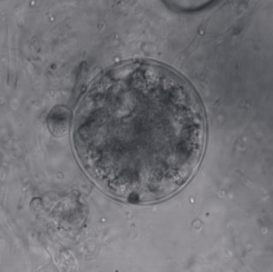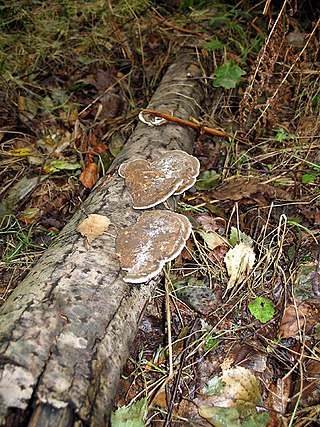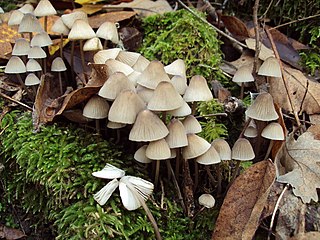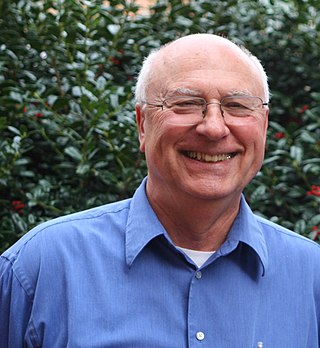
Mycelium is a root-like structure of a fungus consisting of a mass of branching, thread-like hyphae. Its normal form is that of branched, slender, entangled, anastomosing, hyaline threads. Fungal colonies composed of mycelium are found in and on soil and many other substrates. A typical single spore germinates into a monokaryotic mycelium, which cannot reproduce sexually; when two compatible monokaryotic mycelia join and form a dikaryotic mycelium, that mycelium may form fruiting bodies such as mushrooms. A mycelium may be minute, forming a colony that is too small to see, or may grow to span thousands of acres as in Armillaria.

Chytridiomycota are a division of zoosporic organisms in the kingdom Fungi, informally known as chytrids. The name is derived from the Ancient Greek χυτρίδιον (khutrídion), meaning "little pot", describing the structure containing unreleased zoospores. Chytrids are one of the earliest diverging fungal lineages, and their membership in kingdom Fungi is demonstrated with chitin cell walls, a posterior whiplash flagellum, absorptive nutrition, use of glycogen as an energy storage compound, and synthesis of lysine by the α-amino adipic acid (AAA) pathway.

Decomposers are organisms that break down dead organisms and release the nutrients from the dead matter into the environment around them. Decomposition is a chemical process similar to digestion; in fact, many sources use the words digestion and decomposition interchangeably. In both processes, complex molecules are chemically broken down by enzymes into simpler, smaller ones. The term "digestion," however, is most commonly used to refer to food breakdown that occurs within animal bodies, and results in the absorption of nutrients from the gut into the animal's bloodstream. Decomposition happens outside of an organism's body, in the environment. Decomposition is also referred to as external digestion; the decomposer works not by swallowing the dead tissue and then digesting it, but by releasing enzymes directly onto it. After allowing the enzymes time to digest the material, the decomposer then absorbs the nutrients released by the chemical reaction into its cells.

Hericium erinaceus, commonly known as lion's mane mushroom, yamabushitake, bearded tooth fungus, or bearded hedgehog, is an edible mushroom belonging to the tooth fungus group. Native to North America, Europe, and Asia, it can be identified by its long spines, occurrence on hardwoods, and tendency to grow a single clump of dangling spines. The fruit bodies can be harvested for culinary use.

The British Mycological Society is a learned society established in 1896 to promote the study of fungi.

A wood-decay or xylophagous fungus is any species of fungus that digests moist wood, causing it to rot. Some species of wood-decay fungi attack dead wood, such as brown rot, and some, such as Armillaria, are parasitic and colonize living trees. Excessive moisture above the fibre saturation point in wood is required for fungal colonization and proliferation. In nature, this process causes the breakdown of complex molecules and leads to the return of nutrients to the soil. Wood-decay fungi consume wood in various ways; for example, some attack the carbohydrates in wood, and some others decay lignin. The rate of decay of wooden materials in various climates can be estimated by empirical models.

Mycelial cords are linear aggregations of parallel-oriented hyphae. The mature cords are composed of wide, empty vessel hyphae surrounded by narrower sheathing hyphae. Cords may look similar to plant roots, and also frequently have similar functions; hence they are also called rhizomorphs. As well as growing underground or on the surface of trees and other plants, some fungi make mycelial cords which hang in the air from vegetation.

Spalting is any form of wood coloration caused by fungi. Although primarily found in dead trees, spalting can also occur in living trees under stress. Although spalting can cause weight loss and strength loss in the wood, the unique coloration and patterns of spalted wood are sought by woodworkers.

Mycena galopus, commonly known as the milky mycena, milking bonnet or milk-drop mycena, is an inedible species of fungus in the family Mycenaceae of the order Agaricales. It produces small mushrooms that have grayish-brown, bell-shaped, radially-grooved caps up to 2.5 cm (1 in) wide. The gills are whitish to gray, widely spaced, and squarely attached to the stem. The slender stems are up to 8 cm (3 in) long, and pale gray at the top, becoming almost black at the hairy base. The stem will ooze a whitish latex if it is injured or broken. The variety nigra has a dark gray cap, while the variety candida is white. All varieties of the mushroom occur during summer and autumn on leaf litter in coniferous and deciduous woodland.
Michael Francis Madelin (1931–2007) was a British mycologist. He held research faculty positions at Imperial College, University of London, and the University of Bristol, and undertook pioneering research in conidial fungi and slime moulds, with specific reference to their physiology and ecology.

Exidia glandulosa is a species of fungus in the family Auriculariaceae. In the UK, it has the recommended English name of witch's butter. In North America it has variously been called black witches' butter, black jelly roll, or warty jelly fungus. It is a common, wood-rotting species in Europe, typically growing on dead attached branches of oak. The gelatinous basidiocarps are up to 3 cm (1.2 in) wide, shiny, black and blister-like, and grow singly or in clusters. Its occurrence elsewhere is uncertain because of confusion with the related species, Exidia nigricans.

Peniophora quercina is a species of wood-decay fungus in the family Peniophoraceae. It produces fruit bodies that vary in appearance depending on whether they are wet or dry. The wet fruit bodies are waxy and lilac, and attached strongly to the wood on which they grow. When dry, the edges curl up and reveal the dark underside, while the surface becomes crusty and pink. P. quercina is the type species of the genus Peniophora, with the species being reclassified as a member of the genus upon the latter's creation by Mordecai Cubitt Cooke. P. quercina is found primarily in Europe, where it can be encountered all year. Though primarily growing upon dead wood, especially oak, it is also capable of growing upon still-living wood.

Marine fungi are species of fungi that live in marine or estuarine environments. They are not a taxonomic group, but share a common habitat. Obligate marine fungi grow exclusively in the marine habitat while wholly or sporadically submerged in sea water. Facultative marine fungi normally occupy terrestrial or freshwater habitats, but are capable of living or even sporulating in a marine habitat. About 444 species of marine fungi have been described, including seven genera and ten species of basidiomycetes, and 177 genera and 360 species of ascomycetes. The remainder of the marine fungi are chytrids and mitosporic or asexual fungi. Many species of marine fungi are known only from spores and it is likely a large number of species have yet to be discovered. In fact, it is thought that less than 1% of all marine fungal species have been described, due to difficulty in targeting marine fungal DNA and difficulties that arise in attempting to grow cultures of marine fungi. It is impracticable to culture many of these fungi, but their nature can be investigated by examining seawater samples and undertaking rDNA analysis of the fungal material found.

Forensic mycology is the use of mycology in criminal investigations. Mycology is used in estimating times of death or events by using known growth rates of fungi, in providing trace evidence, and in locating corpses. It also includes tracking mold growth in buildings, the use of fungi in biological warfare, and the use of psychotropic and toxic fungus varieties as illicit drugs or causes of death.
Roy Watling is a Scottish mycologist who has made significant contributions to the study of fungi both in the identification of new species and correct taxonomic placement, as well as in fungal ecology.
John Webster was an internationally renowned mycologist and head of biological sciences at the University of Exeter in England. He also served twice as president of the British Mycological Society. He is recognised for determining the physiological mechanism underpinning fungal spore release, though is probably best known by students of mycology for his influential textbook, Introduction to Fungi.

Larry F. Grand was an American mycologist who had a long career focusing on ectomycorrhizal fungi, wood decay fungi and plant pathogenic fungi.

Stephen Denis Garrett was a British plant pathologist and mycologist who did pioneering work on soil-borne pathogens, root pathology and soil ecology. He was the first to apply ecological concepts to interactions in the soil. Much of his research used as a model system the fungus Gaeumannomyces graminis, which causes the important cereal disease take-all. He also studied Armillaria root rot of trees, among other plant diseases.

Tetracladium is a genus of fungi belonging to the order Helotiales. Species within this genus are primarily known for their ubiquitous presence in various habitats, including soil, decaying plant matter, and aquatic environments. The genus name "Tetracladium" derives from the Greek words "tetra," meaning four, and "cladion," meaning branch, referring to the typical branching pattern observed in the conidiophores of these fungi.

Fungi are a common theme and working material in art. Fungi appear in nearly all art forms, including literature, paintings, and graphic arts; and more recently, contemporary art, music, photography, comic books, sculptures, video games, dance, cuisine, architecture, fashion, and design. There are some exhibitions dedicated to fungi, as well as an entire museum.
















